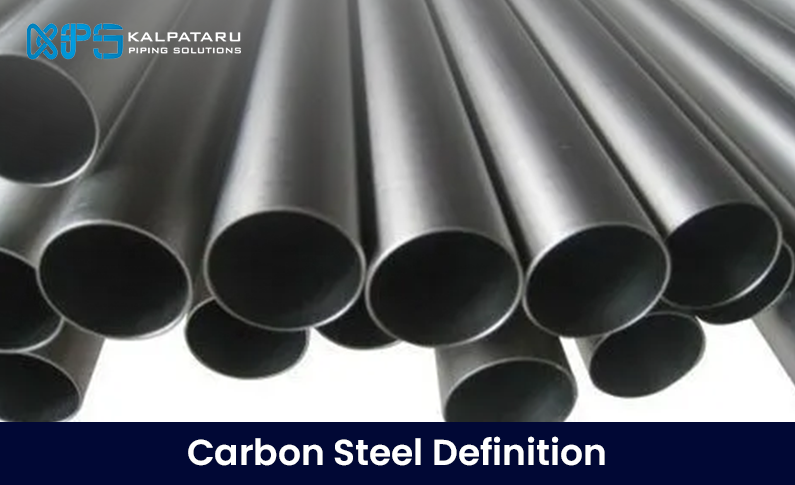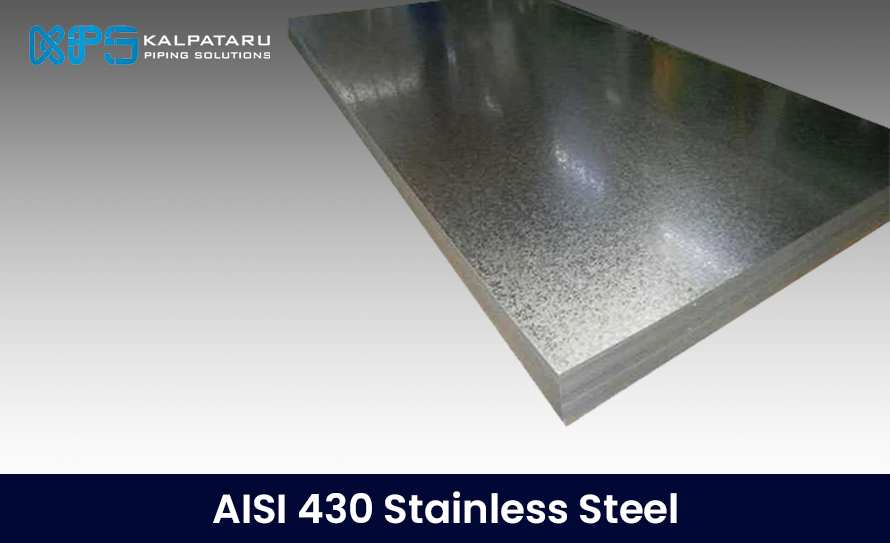Carbon steels are iron-carbon alloys that may contain small amounts of other elements like manganese, silicon, sulfur, and phosphorus. These elements are present due to the steelmaking process but do not significantly impact the overall mechanical properties. Plain carbon steel primarily derives its properties from the amount of carbon present. By adding carbon to iron, the material gains strength while losing some ductility, making it highly versatile for various applications.
Carbon steel properties are influenced by the carbon content, which is typically below 1%. As the carbon percentage increases, the steel becomes strong but less ductile. This balance between strength and flexibility makes carbon metals useful in numerous industries. The American Iron and Steel Institute (AISI) classifies carbon steel into four categories based on its carbon content:
Low-Carbon Steels (Mild Steel):
Contains around 0.05–0.25% carbon. Known for being malleable, ductile, and easy to form. Commonly used due to its low cost and versatility. Can be surface-hardened through carburizing to increase durability.Medium-Carbon Steels:
Contains around 0.3–0.6% carbon. Provides a good balance of strength, wear resistance, and ductility. Often used in machine components like gears, shafts, axles, and railway wheels.High-Carbon Steels:
Contains around 0.6–1.0% carbon. Offers high hardness but reduced ductility. Suitable for springs, cutting tools, and mechanical parts such as wrenches and hammers.Ultra-High-Carbon Steels:
Contains around 1.25–2.0% carbon. Known for exceptional hardness and is used in specialized applications like truck springs, cutting tools, and knives. Steels with more than 2.5% carbon are typically produced using powder metallurgy. The carbon steel properties—its strength, durability, and heat treatment adaptability—make it one of the most commonly used carbon metals in construction, automotive, and manufacturing sectors. Its wide range of applications and affordable cost continue to drive its demand across industries.Types of Carbon Steel Properties
| Carbon content (wt.%) | Microstructure | Properties | Examples | |
|---|---|---|---|---|
| Low-carbon steel | < 0.25 | Ferrite, pearlite | Low hardness and cost. High ductility, toughness, machinability and weldability | AISI 304, ASTM A815, AISI 316L |
| Medium-carbon steel | 0.25 – 0.60 | Martensite | Low hardenability, medium strength, ductility and toughness | AISI 409, ASTM A29, SCM435 |
| High-carbon steel | 0.60 – 1.25 | Pearlite | High hardness, strength, low ductility | AISI 440C, EN 10088-3 |
Low-Carbon Steel
Low-carbon steel, the most widely used form of carbon steel, typically contains less than 0.25% carbon by weight. It cannot be hardened by heat treatment to form martensite; instead, cold working is usually used to increase its strength. These steels are relatively soft, have low strength, but offer high ductility, making them easy to machine and weld. Their low cost makes them popular for various applications.
High-strength, low-alloy steels (HSLA), while sometimes classified as low-carbon steels, also contain small amounts of other elements such as copper, nickel, vanadium, and molybdenum. These elements make up about 10% of the steel’s weight and give HSLA steels increased strength, achieved through heat treatment, while retaining their ductility and making them corrosion-resistant compared to regular low-carbon steel.
Medium-Carbon Steel
Medium-carbon steel contains 0.25–0.60% carbon and 0.60–1.65% manganese. Its strength and hardness are enhanced by heat treatment processes like austenitizing, quenching, and tempering, which create a martensitic structure. This makes medium-carbon steel stronger than low-carbon steel but reduces its ductility and toughness. To improve heat treatment effectiveness and hardenability, elements like chromium, molybdenum, and nickel are often added.
High-Carbon Steel
High-carbon steel has the highest carbon content among the three, ranging from 0.60–1.25%, with manganese content between 0.30–0.90%. This gives it superior hardness and toughness, though at the expense of ductility. High-carbon steels are highly wear-resistant and are often used in hardened and tempered forms. Tool steels and die steels, subtypes of high-carbon steel, contain additional alloying elements like chromium, vanadium, molybdenum, and tungsten, which contribute to the formation of extremely hard carbide compounds like tungsten carbide (WC).
Production and Processing
Carbon steel can be made using recycled steel, virgin steel, or a combination of both. The basic steel production process involves melting iron ore, coke (a form of processed coal), and lime in a blast furnace at around 1650 °C. The molten iron absorbs carbon from the coke, while impurities combine with lime to form slag, which is skimmed off. The molten steel, initially containing about 4% carbon, undergoes decarburization, where oxygen is passed through the steel to reduce the carbon content to the desired level. This process produces carbon monoxide and carbon dioxide, resulting in carbon steel with the required properties.
Comparison of Properties and Applications of Different Grades
| Type | AISI/ASTM name | Carbon content (wt.%) | Tensile Strength (MPa) | Yield Strength (MPa) | Ductility (% elongation in 50 mm) | Applications |
| Low | 1010 | 0.10 | 325 | 180 | 28 | Automobile panels, nails, wire |
| Low | 1020 | 0.20 | 380 | 205 | 25 | Pipes, structural steel, sheet steel |
| Low | A36 | 0.29 | 400 | 220 | 23 | Structural |
| Low | A516 Grade 70 | 0.31 | 485 | 260 | 21 | Low-temperature pressure vessels |
| Medium | 1030 | 0.27 – 0.34 | 460 | 325 | 12 | Machinery parts, gears, shifts, axles, bolts |
| Medium | 1040 | 0.37 – 0.44 | 620 | 415 | 25 | Crankshafts, couplings, cold headed parts. |
| High | 1080 | 0.75 – 0.88 | 924 | 440 | 12 | Music wire |
| High | 1095 | 0.90 – 1.04 | 665 | 380 | 10 | Springs, cutting tools |
Properties of Carbon Steel
Material properties are independent of the amount of material present, meaning they remain consistent regardless of the system’s size or mass. The study of material properties is crucial in materials science, where researchers explore the relationship between a material’s structure and its characteristics (mechanical, electrical, etc.). The chemical elements that make up a material, along with its processing, significantly influence its final properties.
Mechanical Properties of Carbon Steel
Materials are often selected based on their mechanical properties, especially for structural applications. These properties determine how well a material performs under load.
Strength of Carbon Steel
The strength of carbon steel refers to its ability to withstand an applied load without breaking or permanently deforming. When a material can bear a load without failure, it is considered strong. Strength is a key factor in material selection for various applications.
Ultimate Tensile Strength (UTS)
The ultimate tensile strength of low-carbon steel ranges from 400 to 550 MPa. This is the highest stress a material can handle while being stretched before it breaks. After reaching the UTS, the steel may experience necking, where the cross-sectional area narrows, leading to fracture. UTS is an important measure, especially in structural applications where materials are subject to tension.
Yield Strength
The yield strength of low-carbon steel is about 250 MPa. Yield strength defines the stress at which a material starts to deform plastically. Below this point, the material deforms elastically and returns to its original shape once the load is removed. When the yield point is exceeded, permanent deformation occurs.
Young’s Modulus of Elasticity
Young’s modulus of elasticity for low-carbon steel is around 200 GPa. This property measures the stiffness of a material and describes its ability to resist deformation under stress. In the elastic range, stress is proportional to strain, following Hooke’s law. Young’s modulus helps engineers determine how much a material will stretch or compress under a specific load.
Hardness of Carbon Steel
The Brinell hardness of low-carbon steel is approximately 120 HB. Hardness measures a material’s resistance to localized plastic deformation, such as indentation or scratching. In engineering, harder materials tend to have better wear resistance. The Brinell hardness test uses a hardened steel ball pressed into the material’s surface, and the hardness number is calculated based on the indentation size.
Thermal Properties of Carbon Steel
Thermal properties describe how materials respond to heat. As carbon steel absorbs heat, its temperature rises, and it expands. Different materials react to heat in unique ways, affecting their performance in applications involving temperature changes.
FAQs
What is plain carbon steel?
Plain carbon steel is an alloy of iron and carbon, with total alloying elements less than 2% by mass. It has limits of 0.6% for copper, 1.65% for manganese, 0.6% for silicon, 0.04% for phosphorus, and 0.05% for sulfur, with no additional deliberate alloying elements.
What is carbon steel?
Carbon steel is primarily composed of iron and carbon and is categorized into low-carbon and high-carbon steel. It may also contain elements like manganese, phosphorus, sulfur, and silicon, which influence its properties. Carbon steel is known for being easily machined and welded, making it versatile for various applications.
What are the main properties of carbon steel?
The main properties of carbon steel include its high hardness, tensile strength, and wear resistance, particularly in high-carbon steel, which contains 0.60% to 1.5% carbon. The increased carbon content enhances these characteristics, making it more resistant to corrosion compared to lower-carbon steels.




